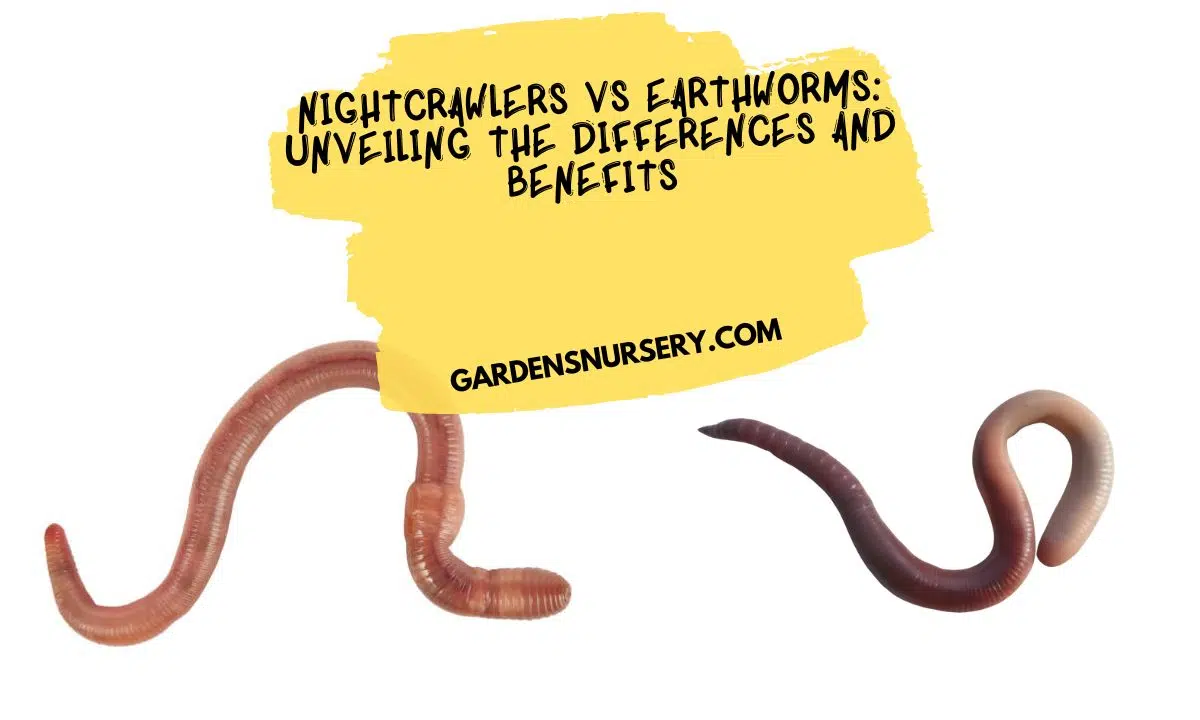Nightcrawlers vs Earthworms: Unveiling the Differences and Benefits
1. Introduction: Understanding Nightcrawlers vs Earthworms
When it comes to the world of worms, nightcrawlers vs earthworms often find themselves in the spotlight. Both these creatures play a crucial role in soil health and nutrient enrichment.
However, there are several differences between them in terms of characteristics, behavior, and habitat preferences. In this article, we will explore the contrasting features of nightcrawlers and earthworms, along with the benefits they offer to gardens and agriculture.
2. Nightcrawlers: Characteristics and Habitat
Nightcrawlers, scientifically known as Lumbricus terrestris, are large worms that belong to the family Lumbricidae. These worms are typically found in temperate regions and are known for their burrowing capabilities.
Nightcrawlers can grow up to 14 inches long and have a cylindrical body with a smooth exterior. They possess a dark reddish-brown color and are commonly active at night, hence the name “nightcrawlers.”
In terms of habitat preference, nightcrawlers tend to thrive in well-drained soil with high organic matter content. They create deep vertical burrows, which can extend several feet below the surface.
These burrows help in aeration, allowing oxygen to reach the roots of plants. Nightcrawlers prefer slightly acidic to neutral soil conditions and are commonly found in grasslands, forests, and agricultural fields.
3. Earthworms: Traits and Environment
Earthworms, also known as Oligochaeta, belong to the phylum Annelida. They are segmented worms with cylindrical body and a slimy exterior. Earthworms can vary in size, ranging from a few inches to a foot long, depending on the species. Unlike night crawlers, earthworms are active during the day and can be found burrowing through the soil.
Earthworms inhabit a wide range of environments, including forests, gardens, and agricultural fields. They prefer moist soil conditions and can tolerate a slightly wider range of pH levels compared to nightcrawlers. These adaptable creatures help to enhance soil fertility and structure through their burrowing activities and nutrient-rich castings.
4. Nightcrawlers vs Earthworms: Size and Appearance
Nightcrawlers and earthworms may seem similar at first glance, but there are noticeable differences in their size and appearance. Nightcrawlers are significantly larger, with some individuals reaching lengths of up to 14 inches.
They have a smooth and shiny skin texture, which distinguishes them from earthworms. In contrast, earthworms are generally smaller, ranging from a few inches to a foot in length, depending on the species.
Additionally, the coloration of nightcrawlers and earthworms differs. Nightcrawlers have a dark reddish-brown color, while earthworms can vary in color from pale pink to reddish-brown or even dark brown. Earthworms also have a segmented body, with each segment connected by a distinct ring, giving them a ringed or striped appearance.
5. Behavior and Feeding Habits
Nightcrawlers and earthworms exhibit different behaviors and feeding habits, which contribute to their respective roles in soil health.
Nightcrawlers are primarily nocturnal creatures, meaning they are most active during the night. They emerge from their burrows to forage on decaying organic matter, such as dead leaves, plant debris, and other decomposing material found on the soil surface. Nightcrawlers are detritivores, meaning they consume dead organic material and help break it down into smaller particles.
On the other hand, earthworms are more active during the day and tend to stay closer to the soil surface. They consume a wide variety of organic matter, including decaying plant material, bacteria, fungi, and other microorganisms.
Earthworms play a crucial role in soil aeration and nutrient cycling. As they feed, they ingest soil along with the organic matter, and the soil passes through their digestive system, creating nutrient-rich castings that improve soil fertility.
6. Soil Health and Nutrient Enrichment
Both nightcrawlers and earthworms contribute significantly to soil health and nutrient enrichment, albeit in different ways.
Nightcrawlers, with their burrowing activities, create extensive vertical burrows in the soil. These burrows serve as channels for air and water movement, facilitating better drainage and aeration.
The burrows also provide pathways for plant roots to grow deeper, accessing nutrients and moisture from lower soil layers. Additionally, the burrowing action of nightcrawlers helps to mix organic matter into the soil, promoting decomposition and nutrient release.
Earthworms, through their burrowing and feeding activities, enhance soil structure and fertility. As they consume organic matter, they break it down into smaller particles, increasing the surface area available for decomposition by microorganisms.
The castings excreted by earthworms are rich in nutrients like nitrogen, phosphorus, and potassium, making them readily available for plant uptake. Earthworm burrows also improve soil porosity, allowing for better water infiltration and root penetration.
7. Benefits of Nightcrawlers in Gardening and Agriculture
Nightcrawlers offer several benefits when it comes to gardening and agriculture:
a) Enhanced Soil Structure:
The burrowing activity of nightcrawlers helps to loosen compacted soil, improving its structure and promoting root growth. This results in better nutrient and water absorption by plants.
b) Nutrient Cycling:
Nightcrawlers aid in the breakdown of organic matter, accelerating the decomposition process. This leads to the release of nutrients that are essential for plant growth and vitality.
c) Aeration and Drainage:
The vertical burrows created by nightcrawlers improve soil aeration and drainage, preventing waterlogging and allowing roots to access oxygen more effectively.
d) Increased Water Infiltration: Earthworm burrows create channels in the soil, allowing for better water infiltration. This helps prevent soil erosion, improves moisture distribution, and reduces the risk of waterlogging.
e) Seed Germination and Plant Growth: The improved soil structure, nutrient availability, and aeration facilitated by earthworm activity promote seed germination and overall plant growth. Earthworms create an optimal environment for root development, leading to healthier and more vigorous plants.
9. Frequently Asked Questions (FAQs)
Are nightcrawlers and earthworms the same thing?
No, nightcrawlers and earthworms are not the same. While they both belong to the same phylum (Annelida) and play important roles in soil health, they have distinct characteristics, behaviors, and preferences.
Can nightcrawlers and earthworms coexist in the same habitat?
Yes, nightcrawlers and earthworms can coexist in the same habitat, as they have different feeding habits and occupy different soil layers. They often complement each other in promoting soil health and nutrient cycling.
Which worm is better for vermicomposting?
Both nightcrawlers and earthworms can be used for vermicomposting, but red wigglers (Eisenia fetida) are commonly preferred for their fast reproductive rate and efficient composting abilities.
Do nightcrawlers and earthworms have any predators?
Yes, nightcrawlers and earthworms have natural predators, including birds, frogs, toads, snakes, and certain mammals like moles and shrews. These predators feed on worms as a part of their diet.
How can I attract nightcrawlers or earthworms to my garden?
To attract nightcrawlers and earthworms to your garden, you can follow these practices:
- Minimize or eliminate the use of synthetic chemicals, such as pesticides and herbicides, which can be harmful to worms.
- Add organic matter, such as compost or well-rotted manure, to your soil to provide a food source for worms.
- Mulch your garden beds to retain moisture and create a favorable environment for worms.
- Avoid over-tilling the soil, as it can disrupt worm populations and their burrows.
- Keep your garden adequately watered, as worms require moisture to thrive.
Creating a worm-friendly environment will encourage nightcrawlers and earthworms to take up residence in your garden and contribute to its overall health.
10. Conclusion
In the realm of soil-dwelling creatures, both nightcrawlers and earthworms play vital roles in promoting soil health, enhancing nutrient cycling, and improving plant growth. Nightcrawlers excel in deep burrowing and aeration, while earthworms excel in nutrient enrichment and soil structure improvement.
Understanding the distinctions between nightcrawlers and earthworms allows us to appreciate the unique benefits they bring to gardens and agricultural systems. By incorporating practices that support and attract these beneficial worms, such as maintaining organic matter, avoiding chemical use, and providing a conducive environment, we can harness their power to create thriving ecosystems and bountiful harvests.
So, whether you choose to embrace the impressive burrowing capabilities of nightcrawlers or harness the nutrient-rich castings of earthworms, both of these fascinating creatures have their place in the world beneath our feet, working tirelessly to improve soil health and contribute to the success of our gardens and farms.
Read More: Red Wiggler Worms










